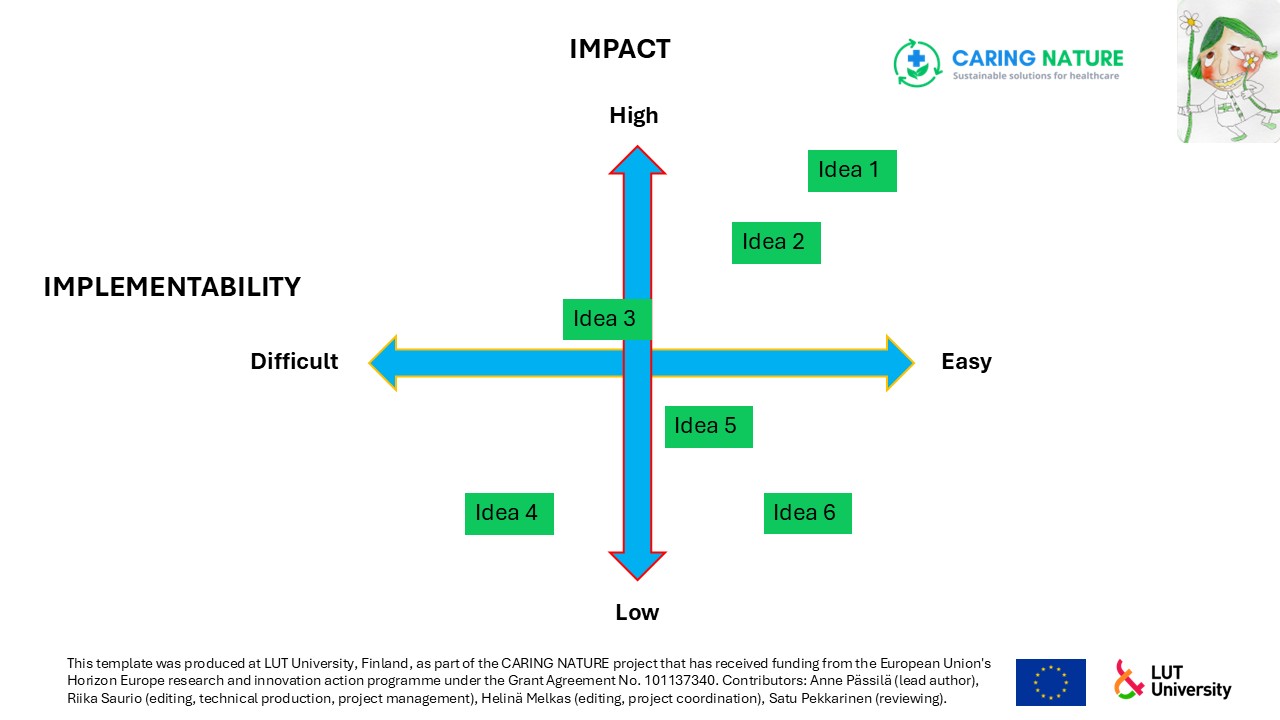A FOUR-FIELD STRUCTURING MODEL FOR IDEA GENERATION ON THE GREEN TRANSITION
Paradigm-preserving methods
The four-field structuring model is an effective method for grouping and assessing ideas related to the green transition. It helps to visualise and prioritise ideas using a four-field structure, where the axes can represent, for example, impact and implementability. The method can be adapted to different needs related to the green transition in a health and care organisation.
What is required:
- Participants should be able to critically assess and analyse ideas.
- Participants should understand the resources required to implement an idea and understand what resources the organisation has.
- Participants must be committed to the process and willing to invest time and effort in developing and implementing the idea.
- Requires flexibility, as idea development is an iterative process, so participants must be prepared to make changes and improvements along the way.
- Participants must be prepared to give and receive feedback. This will help to improve the idea and ensure that it works.
Level of difficulty: 1-3, depending on the nature of the issue to be developed
Time required: 30-60 minutes
Materials:
- Ideas on individual post-it notes
- A large piece of paper on which to draw the four-field structure or a digital platform (such as Miro)
Participants: 1-30 participants
How to use:
- Define the axes: choose two criteria to assess the ideas. Common criteria are impact (high/low) and implementability (easy/difficult).
- Draw a grid: draw a grid with the horizontal axis representing one criterion (e.g. implementability) and the vertical axis representing the other criterion (e.g. impact).
- Place the ideas: place the ideas in the grid based on the assessment criteria. For example, an idea that is easy to implement and has a high impact is placed in the top right corner.
- Analyse and prioritise: The structure helps to identify which ideas are worth implementing. Ideas that are placed in the top right corner (high impact, easy to implement) tend to be prioritised. Ideas in the bottom left corner (low impact, difficult to implement) may be less prioritised.
When to use:
- The method can be used at different stages of the development process – idea generation, conceptualisation and piloting and as a tool for evaluating and monitoring implementation.
Why to use:
- Helps to clarify which ideas are worth taking forward and which require additional resources or development.
- Helps to identify ideas that may be risky or require a high level of resources in relation to their impact. This in turn helps to avoid failures and better manage risks.
- The four-field structure provides a common language and structure for team members to discuss and assess ideas together.
How to document:
- Photograph the different steps
- Take notes
The roots of the method can be found here: The method is rooted in open innovation activities, innovation management and innovation processes, which deal with the collection, organisation and development of ideas (Chesbrough, 2003; 2012).
